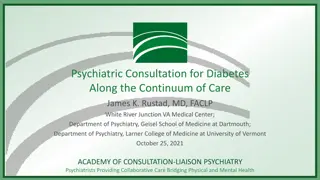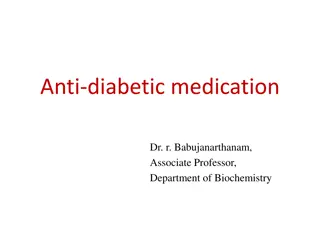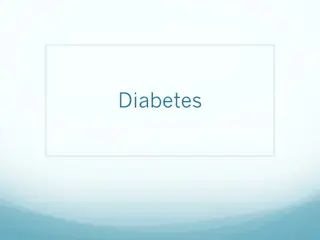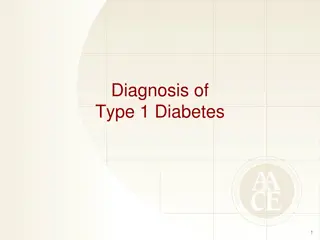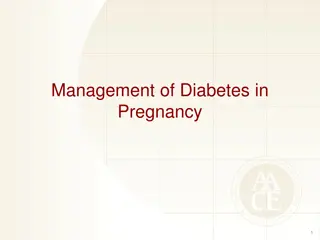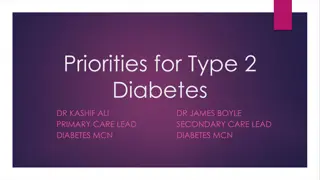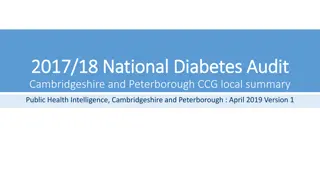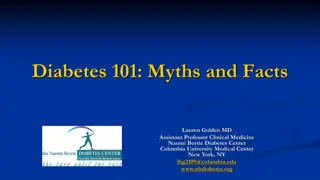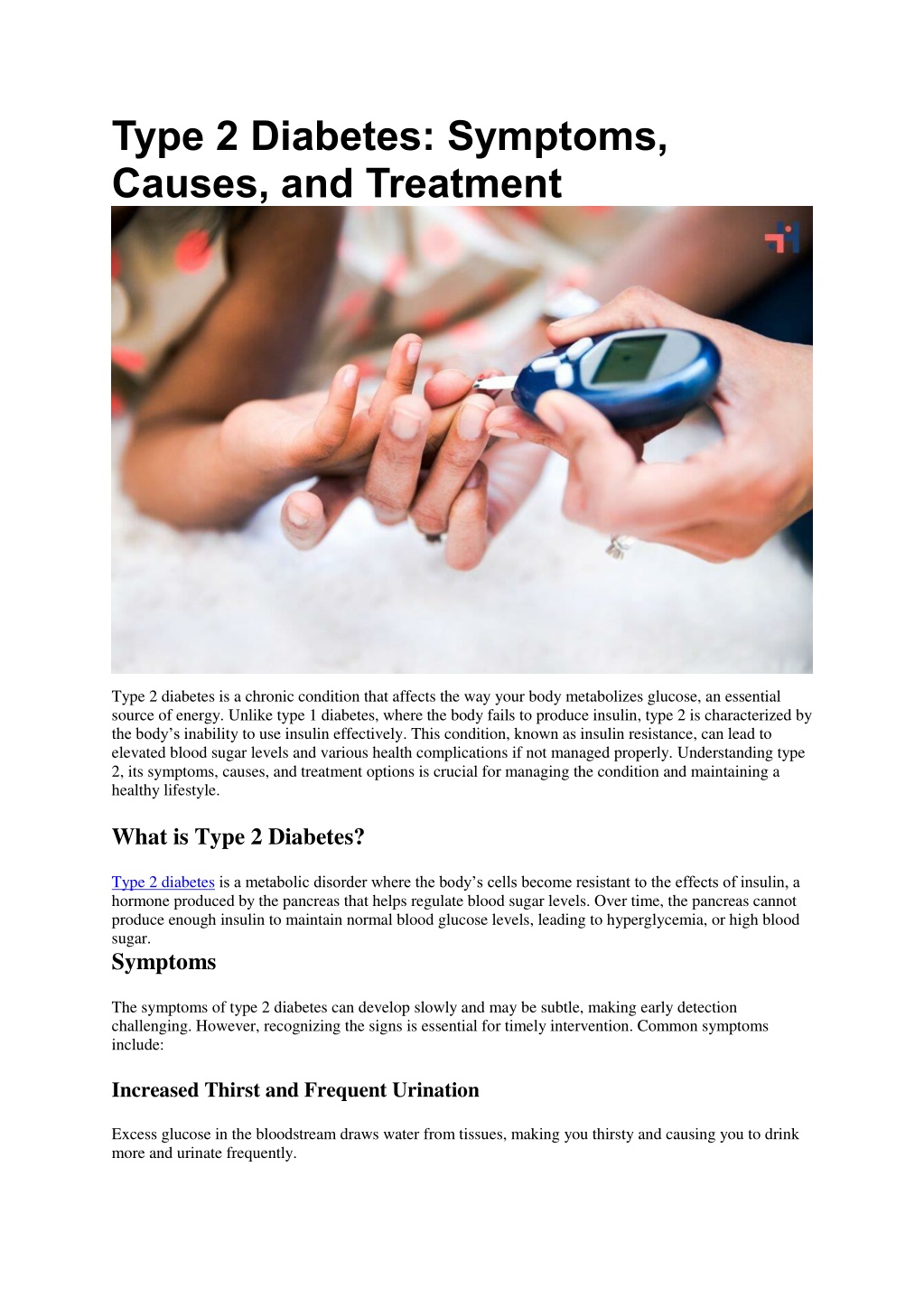
Type 2 Diabetes
Understanding type 2 diabetes, its symptoms, causes, and treatment options is crucial for managing the condition and maintaining a healthy lifestyle.
Uploaded on | 0 Views
Download Presentation

Please find below an Image/Link to download the presentation.
The content on the website is provided AS IS for your information and personal use only. It may not be sold, licensed, or shared on other websites without obtaining consent from the author. If you encounter any issues during the download, it is possible that the publisher has removed the file from their server.
You are allowed to download the files provided on this website for personal or commercial use, subject to the condition that they are used lawfully. All files are the property of their respective owners.
The content on the website is provided AS IS for your information and personal use only. It may not be sold, licensed, or shared on other websites without obtaining consent from the author.
E N D
Presentation Transcript
Type 2 Diabetes: Symptoms, Causes, and Treatment Type 2 diabetes is a chronic condition that affects the way your body metabolizes glucose, an essential source of energy. Unlike type 1 diabetes, where the body fails to produce insulin, type 2 is characterized by the body s inability to use insulin effectively. This condition, known as insulin resistance, can lead to elevated blood sugar levels and various health complications if not managed properly. Understanding type 2, its symptoms, causes, and treatment options is crucial for managing the condition and maintaining a healthy lifestyle. What is Type 2 Diabetes? Type 2 diabetes is a metabolic disorder where the body s cells become resistant to the effects of insulin, a hormone produced by the pancreas that helps regulate blood sugar levels. Over time, the pancreas cannot produce enough insulin to maintain normal blood glucose levels, leading to hyperglycemia, or high blood sugar. Symptoms The symptoms of type 2 diabetes can develop slowly and may be subtle, making early detection challenging. However, recognizing the signs is essential for timely intervention. Common symptoms include: Increased Thirst and Frequent Urination Excess glucose in the bloodstream draws water from tissues, making you thirsty and causing you to drink more and urinate frequently.
Increased Hunger Without enough insulin to move glucose into your cells, your muscles and organs become depleted of energy, triggering intense hunger. Unexplained Weight Loss Despite eating more, you may lose weight because your body cannot efficiently use glucose for energy and starts breaking down muscle and fat for fuel. Fatigue Insufficient insulin means your cells don t get the energy they need, leading to feelings of tiredness and fatigue. Blurred Vision High blood sugar levels can pull fluid from the lenses of your eyes, affecting your ability to focus. Slow-Healing Sores or Frequent Infections It can impair your body s ability to heal and fight infections, making you more susceptible to skin and urinary tract infections. Darkened Skin Some people with type 2 diabetes develop dark, velvety patches of skin, typically in the folds and creases of the body (acanthosis nigricans).
Causes and Risk Factors The exact cause of type 2 diabetes is not fully understood, but it is believed to result from a combination of genetic and environmental factors. Genetic Factors Family history plays a significant role in the development of type 2 diabetes. Certain genes can increase the risk of insulin resistance and obesity. Obesity and Physical Inactivity Excess body fat, particularly around the abdomen, is strongly linked to insulin resistance. Lack of physical activity further exacerbates this risk. Age The risk of type 2 increases with age, particularly after age 45, although it is becoming more common in younger populations, including children and adolescents. Ethnicity People of certain ethnic backgrounds, such as African American, Hispanic, Native American, and Asian American, have a higher risk of developing type 2. Unhealthy Diet A diet high in refined carbohydrates, sugary beverages, and unhealthy fats can contribute to weight gain and insulin resistance. Polycystic Ovary Syndrome (PCOS) Women with PCOS, a condition characterized by irregular menstrual periods, excess hair growth, and obesity, have an increased risk of type 2. High Blood Pressure and High Cholesterol
These conditions often accompany type 2 diabetes and are part of the metabolic syndrome, a cluster of conditions that increase the risk of heart disease and diabetes. Diagnosing Early diagnosis of type 2 diabetes is crucial for effective management and prevention of complications. Healthcare providers use several tests to diagnose the condition: Fasting Blood Sugar Test Measures blood glucose levels after an overnight fast. A fasting blood sugar level of 126 mg/dL or higher on two separate tests indicates diabetes. A1C Test Provides an average blood sugar level over the past two to three months. An A1C level of 6.5% or higher on two separate tests indicates diabetes. Oral Glucose Tolerance Test (OGTT) Measures blood sugar levels before and two hours after drinking a glucose-rich beverage. A reading of 200 mg/dL or higher after two hours indicates diabetes. Random Blood Sugar Test Measures blood sugar levels at any time. A reading of 200 mg/dL or higher, along with diabetes symptoms, indicates diabetes.
Treatment Options Managing type 2 diabetes involves a combination of lifestyle changes, medication, and regular monitoring of blood sugar levels. The primary goals are to keep blood sugar levels within a target range and prevent complications. Lifestyle Changes Healthy Eating: Focus on a balanced diet rich in fruits, vegetables, whole grains, lean proteins, and healthy fats. Limit intake of refined carbohydrates, sugary foods, and saturated fats. Regular Physical Activity: Aim for at least 150 minutes of moderate aerobic activity, such as brisk walking or swimming, per week, along with strength training exercises. Weight Management: Losing weight through a healthy diet and regular exercise can significantly improve blood sugar control. Medications Metformin: Often the first medication prescribed for type 2 diabetes, it helps lower blood sugar levels by reducing glucose production in the liver and improving insulin sensitivity. Sulfonylureas: Stimulate the pancreas to produce more insulin. Meglitinides: Stimulate the pancreas to produce more insulin but act more quickly than sulfonylureas. Thiazolidinediones: Improve insulin sensitivity. DPP-4 Inhibitors: Help reduce blood sugar levels without causing weight gain. GLP-1 Receptor Agonists: Slow digestion and help lower blood sugar levels. SGLT2 Inhibitors: Prevent the kidneys from reabsorbing glucose into the blood and instead excrete it in the urine. Insulin Therapy: Sometimes necessary for individuals who cannot achieve target blood sugar levels with oral medications. Monitoring Blood Sugar Levels Regular monitoring helps track blood sugar levels and assess the effectiveness of treatment. This can involve self-monitoring with a glucose meter or continuous glucose monitoring (CGM) systems. Regular Medical Checkups Regular visits to a healthcare provider for monitoring and managing complications such as cardiovascular disease, kidney damage, and nerve damage. Living with Type 2 Managing type 2 diabetes is a lifelong commitment that involves making healthy lifestyle choices and staying informed about the condition. Here are some tips for living well with diabetes: Educate Yourself Learn as much as you can about type 2 diabetes to make informed decisions about your health. Build a Support Network Connect with family, friends, and support groups to share experiences and receive encouragement. Stay Active
Incorporate physical activity into your daily routine. Find activities you enjoy to make exercise a regular part of your life. Monitor Your Health Keep track of your blood sugar levels, medications, and lifestyle changes. Regularly check your feet for sores or infections and schedule routine eye and dental exams. Manage Stress Practice stress-reducing techniques such as meditation, deep breathing, yoga, or hobbies you enjoy. Plan Ahead Prepare for travel, dining out, and special occasions by planning your meals and medication schedule in advance. Conclusion Type 2 diabetes is a manageable condition with the right combination of lifestyle changes, medication, and regular monitoring. Early diagnosis and proactive management are crucial for preventing complications and maintaining a high quality of life. If you or a loved one is experiencing symptoms of type 2 diabetes, consult a healthcare provider for a comprehensive evaluation and personalized treatment plan. References American Diabetes Association Mayo Clinic
By staying informed and proactive, individuals with type 2 diabetes can effectively manage their condition and lead fulfilling, healthy lives. Working closely with healthcare providers and making informed lifestyle choices are key steps in navigating the challenges posed by this condition. Centers for Disease Control and Prevention (CDC) Find practical solutions to common challenges through our insightful articles on Healthcare 360 Magazine




